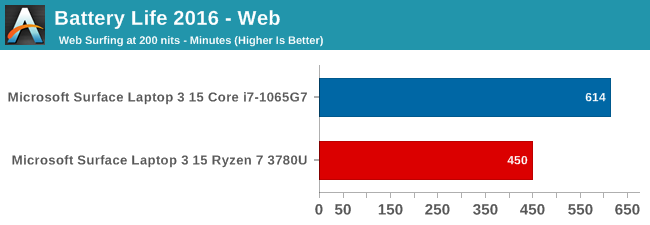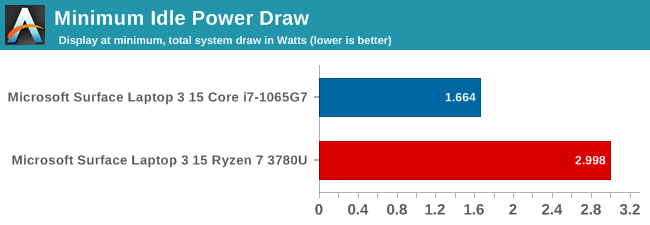The Microsoft Surface Laptop 3 Showdown: AMD's Ryzen Picasso vs. Intel's Ice Lake
by Brett Howse & Andrei Frumusanu on December 13, 2019 8:30 AM ESTPlatform Power
Performance aside, the other side of the coin is battery life. AMD made big gains in battery life with the Ryzen 3000 series, somewhat addressing the power requirements of the platform and getting rid of some of the excessive idle power draw, but they are still using DDR4 on their mobile platform, which puts them at a disadvantage right out of the gate. Intel has made very good gains in battery life over the last several generations, and the move to 10 nm for Ice Lake also brought along LPDDR4X support. Most of the previous generation laptops stuck with LPDDR3, unless the manufacturer needed more than 16 GB of RAM, where they’d be forced to switch to DDR4. Finally adding LPDDR4X support is something that Intel has needed to do for a while, and ironically Intel’s flagship Core product line lagged behind their low-cost Atom lineup which did support LPDDR4.
Web Battery Life

The Ryzen 7 3780U powered Surface Laptop 3 was slightly under the Ryzen 5 device we tested at launch, but still in the same range. The AMD system isn’t helped very much by Microsoft only offering a 46 Wh nominal battery capacity, which is rather undersized for a 15-inch laptop. The Ice Lake device, as we’ve seen before, was much more efficient under load, offering a sizeable battery life lead.
Idle Power
One of AMD’s biggest challenges was to get their laptop SoC into a premium device, and with the Surface Laptop 3 they have succeeded. Microsoft has shown themselves as being adept at squeezing battery life out of devices, with low-power displays, and good internal components to minimize power draw. Here Intel has held a considerable advantage over the last couple of years, and the move to 10 nm should, in theory, help as well.
To test the idle power draw of both systems, the battery discharge rate was monitored with the screens fixed in at 5.35 nits, to minimize the power draw of the display on the result. Normally we’d prefer to have the display completely off for this test, but Microsoft’s power plan on the Surface Laptop actively turns off the laptop when the display times out.

The Ice Lake system was able to go all the way down to right around 2 Watts of power draw – and sometimes slightly under – with as low as 1.7 Watts seen. We’ve seen under 1 Watt of draw on an 8th generation Core Y series processor, and around 1.5 Watts on the same generation U series, so considering the display is not completely off on the Surface Laptop, the 2-Watt draw is quite reasonable.
The Picasso system was not quite as efficient, drawing 3 Watts at idle. This is in-line with the results we’ve seen on other Picasso systems and explains the lower battery life results on the AMD system. AMD made big gains moving from Raven Ridge to Picasso, but I’m sure the team is looking forward to the 7 nm Zen 2 coming to their laptops, which we hope will address this further.










174 Comments
View All Comments
Andrei Frumusanu - Friday, December 13, 2019 - link
Correct. Between 3-5 hours each ST and MT.Fataliity - Friday, December 13, 2019 - link
"despite this being a 3.9 GHz chip, in single-threaded SPEC 2017, it managed to come very close to a 5.0 GHz Core i9-9900K with a massively higher TDP"This statement is contradictory. "Single-Threaded" Spec, then "Massively higher tdp" 9900k is 8 cores. which reflects the TDP. Single-Thread is one core, which is completely different. If you scale up the frequency / wattage graph, a Ice Lake 3.5GHz at 8 cores would be about 100 watts. Which im pretty sure is really close to a 9900k off the top of my head. Except this is at 3.5 and 9900k is hitting 5GHz.
tipoo - Friday, December 13, 2019 - link
Shame AMD didn't have 7nm Zen 2 for mobile ready in time for this. Maybe that's when the partnership will make more sense, until then I wish the consumer 15" was also Ice Lake.s.yu - Friday, December 13, 2019 - link
The difference is too great. This is almost an i3 to i7 comparison, while the price difference is confusingly little. Though the Intel version could be hard to acquire, whoever's interested in this model should aim for the Intel version, even through unofficial channels.eastcoast_pete - Friday, December 13, 2019 - link
Interesting! Guess Chipzilla is (still) king of the hill in mobile; quite impressive, as this IL i7 even comes close to desktop i7 speeds. AMD really needs to get 7 nm Zen2 or Zen2+ into mobile APUs pronto - they're leaving a lot of money on the table. Now is the time, before chipzilla gets their manufacturing problems worked out!MBarton - Monday, December 30, 2019 - link
Less impressive when you consider the amount of money and number of defective CPU's required by Intel fabs to get to this point. When you factor in how much money Intel has dumped into their 10nm process over the last decade the money they're making off of 10 nm is sad.Consumer1 - Friday, December 13, 2019 - link
Interesting to me is the slow speed of the memory with the Ryzen. Ryzen does better with faster memory. To bad we can't equalize the memory to see the effect.Dustin Sklavos - Friday, December 13, 2019 - link
I would never in a million years accuse AnandTech writers of being shills.That said, you guys didn't notice the Ice Lake CPU was being allowed to peak and sustain a solid 8W higher than the Ryzen CPU was?
Yes, even with the higher ceiling on Ice Lake, it's able to bring its idle draw down way lower than Ryzen's, so the bursty nature of garden variety on-battery web surfing is going to heavily favor Ice Lake.
But plugged in, full bore benchmarks, the Ice Lake unit is at a clear advantage for power budget and that's concerning. It's not really as fair a fight when the Ryzen is being kneecapped, and while I don't think it would change the overall results, I *do* think the CPU tests wouldn't be the bloodbath that they are, and the GPU tests (and especially gaming tests) would be a clearer cut win for AMD.
Brett Howse - Saturday, December 14, 2019 - link
I mentioned this in the text but the data logging tool is monitoring CPU core power on Ryzen and SoC package power on Core so the data isn't 100% comparable just due to what each company exposes to be monitored. If you look at the CPU temperatures on the Cinebench R20 test as an example the CPU temperatures are very similar so I don't think the power budget is as far off as you'd think, although Intel is pretty aggressive with boost.Fataliity - Saturday, December 14, 2019 - link
Zen+ APU is also a 216mm die vs Intel's 125mm die. So it has double the surface area, which should mean almost double the heat dissipation (maybe less). So Intel's numbers being twice as high in power draw actually makes sense when you consider the area that is dissipating the heat.